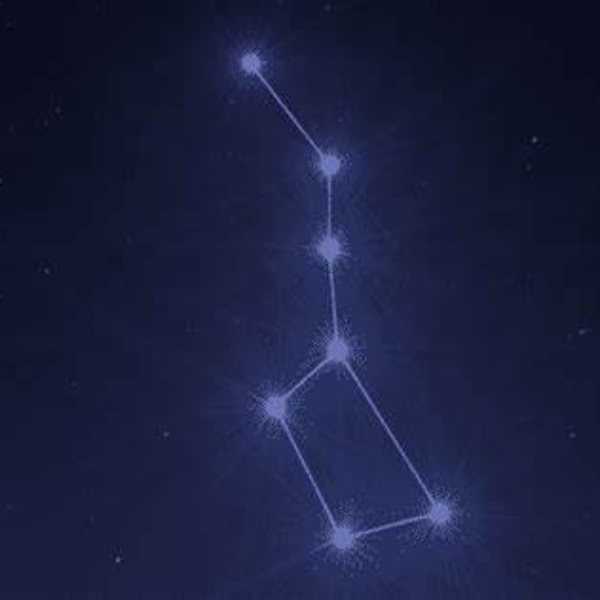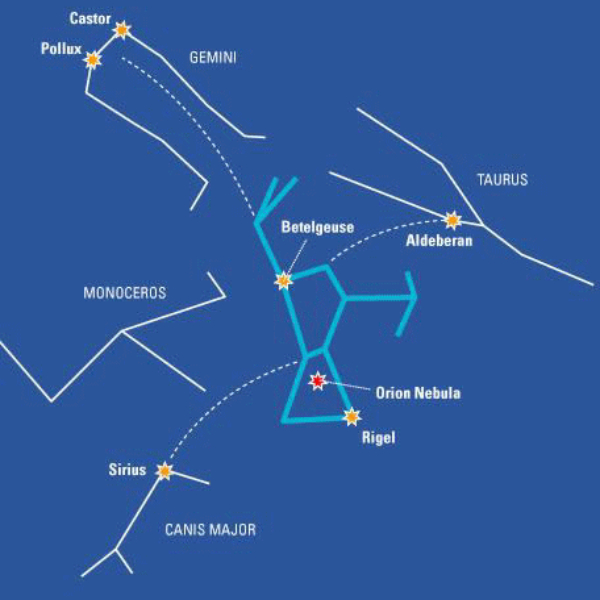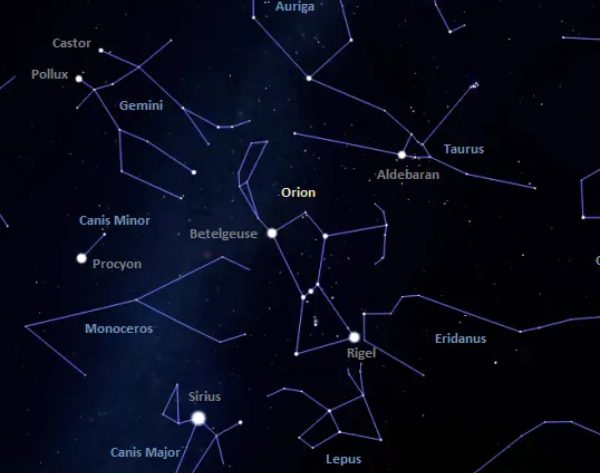Introduction to the Big Dipper and Orion’s Belt
For night sky enthusiasts, two groups of stars stand out: the Big Dipper and Orion’s Belt. The Big Dipper, part of Ursa Major, often serves as a guide to finding the North Star. Orion’s Belt, on the other hand, is famous for its three aligned, bright stars. Although many call these shapes constellations, they are asterisms. Asterisms are star patterns that are not official constellations but are remarkable and distinct.

The Big Dipper leads us to Ursa Major, reflecting its larger constellation. The dipper’s handle arcs to Arcturus and speeds on to Spica; astronomers call this trick arc-to-Arcturus and speed-on-to-Spica. Orion’s Belt points towards Sirius, the brightest star in our sky. These stars help us map the heavens and have done so for centuries.
Not just navigational aids, these asterisms carry rich myths. Every culture has tales spun around these starry sights. The Big Dipper and Orion’s Belt have served sailors and travelers alike in their journeys. Therefore, understanding these star patterns is a mix of learning their alignment and appreciating their stories. As we dive into the mythology and celestial roles they play, we begin to grasp their timeless allure.
Both patterns are easily spotted and beloved by star gazers around the world. In many ways, they are like celestial landmarks that connect us to the vast universe. Learning how to find them is a good starting point for any budding astronomer. It opens a door to the wonders of the night sky.
The Mythology Behind Constellations and Asterisms
The night sky is rich with stories, and constellations and asterisms carry a treasure trove of myths. Long before the modern era, civilizations looked to the stars and saw figures and tales that reflected their cultures and beliefs.
Constellations, officially recognized and mapped out by the International Astronomical Union, often represent characters or creatures from ancient mythologies. Take, for example, Ursa Major, housing the Big Dipper; it’s commonly known as the Great Bear, a form seen in various myths, especially in Greek and Native American folklore.
Asterisms, while not officially classified constellations, have not been left without stories. The Big Dipper has been viewed as a plow or wagon in Western cultures, while in Hindu mythology, it’s seen as the seven great sages, the Saptarishi. These bright patterns in the sky serve as the backdrop for a multitude of legendary narratives across civilizations.
Orion’s Belt uniquely holds tales that transcend cultures. In Greek mythology, Orion was a giant huntsman placed amongst the stars by Zeus. In Egyptian lore, the stars of Orion’s Belt are linked to Osiris, the god of the afterlife. Every clear night offers a view of these ancient stories, told through the stars.
Understanding the mythology behind constellations and asterisms adds a layer of wonder to stargazing. These stories provide context and connection, tying us to our ancestors who first named the stars. They serve not only as guides across the sky but also as links to the human spirit and imagination that has always sought to understand and explain the universe.
Understanding the Big Dipper’s Role in Ursa Major
The Big Dipper is more than just a recognizable pattern in the night sky; it’s an integral part of the larger constellation Ursa Major, also known as the Great Bear. The dipper serves as a navigational tool, its bold form helping observers trace their way across the celestial sphere to other important stars and constellations. Here’s how the Big Dipper fits into the grand scheme of Ursa Major and the stories it tells:
- The Pointer Function: The two stars at the end of the Big Dipper’s ‘bowl’, Dubhe and Merak, are commonly called ‘The Pointers’. They direct sky gazers to Polaris, the North Star, which marks the current northern celestial pole.
- Astronomical Importance: Being part of a larger constellation means the Big Dipper shares Ursa Major’s significance in various celestial studies and observations. The area around it is rich in deep-sky objects, like the Pinwheel Galaxy (M101), making it a favorite hunting ground for astronomers.
- Cultural Significance: The Big Dipper has been associated with various legends and lore, providing a cultural backdrop to this celestial feature. In many myths, it is often depicted as a bear, with different stories explaining how it ascended to the night sky.
- The Shape and Change: Over the millennia, the apparent shape of the Big Dipper has changed due to the proper motion of its stars. This motion is a reminder that our night sky is dynamic and ever-evolving.
In understanding this famous asterism’s role within Ursa Major, we gain a greater appreciation for its place in both astronomy and cultural history. Its familiarity and usefulness in navigation have cemented its status as one of the most important features in our night sky.

Orion’s Belt: The Three Bright Stars
Orion’s Belt dazzles onlookers with its three luminescent stars. It is an easily identifiable line in the night sky. These stars—Alnitak, Alnilam, and Mintaka—shine brightly, woven into Orion the Hunter’s mythology.
Each star in Orion’s Belt is unique and massive. They appear aligned but are light-years apart in space. Alnitak sits on the Belt’s eastern end. It’s a fiery giant over 20 million miles wide. Next, Alnilam glows in the middle, sparkling like a rare gem. It measures around 26 million miles across. Finally, Mintaka anchors the western part. It, too, is a colossal star, shining from 900 light years away.
Together, these stars form not just an asterism, but a beacon in our cosmos. They bridge the past with the present, filling the sky with wonder. Orion’s Belt has served as a celestial compass, guiding travelers in both land and sea. Its stars have also marked seasons, as they rise and set throughout the year.
The brilliance of Orion’s Belt has sparked creativity and storytelling. Ancient Egyptians saw it as their god Osiris’s resting place. In modern times, astronomers continue to study these stars. Their fascination reveals more about our universe.
Orion’s Belt, then, is a testament to the immense beauty and richness of the night sky. It invites us to look up and explore the tales and science of the stars.
How to Locate the Big Dipper and Orion’s Belt in the Night Sky
Finding the Big Dipper and Orion’s Belt is a rewarding experience for any stargazer, from beginners to seasoned observers. With clear skies and little to no light pollution, you can spot these distinctive star patterns. Here are some tips to guide you through the stars:
- Best Time to View: Look for the Big Dipper and Orion’s Belt on clear nights. The Big Dipper is visible all year round from the Northern Hemisphere. Orion’s Belt is best observed in winter and early spring evenings.
- Finding the Big Dipper: Start by facing north. The Big Dipper looks like a ladle or spoon. Look for its ‘bowl’ and ‘handle’, and identify the seven bright stars that make its form.
- Using the Big Dipper: Once you’ve located the Dipper, you can find Polaris. Draw a line between the ‘pointers’, Dubhe and Merak, to reach the North Star.
- Locating Orion’s Belt: After sunset, face south and search for three bright stars aligned in a row. These stars make up Orion’s Belt and are part of the larger Orion constellation.
- Star Identification: Remember the names of Orion’s stars – Alnitak, Alnilam, and Mintaka. They can help confirm you’ve found the right asterism.
With these steps, you can enjoy the magnificent view of the Big Dipper’s guidance and Orion’s Belt’s glowing path. Such celestial navigation is rooted in history and continues to fascinate us with its simplicity and beauty.

The Astronomical Significance of the Big Dipper and Orion’s Belt
The Big Dipper and Orion’s Belt hold great astronomical significance. These patterns are not just stunning to behold; they are keys to understanding the cosmos. Here’s why they are important:
- Navigation: Since ancient times, the Big Dipper has helped people find the North Star, Polaris. This is crucial for navigation. Likewise, Orion’s Belt points to Sirius, aiding in celestial orientation.
- Astronomy’s Tools: These asterisms serve as reference points. Astronomers use them to locate other stars and galaxies. They are also used to teach astronomy basics.
- Scientific Study: The stars in these patterns are subjects of intense study. Through them, we learn about star formation, distance, and composition.
- Constellations vs. Asterisms: It’s important to note the Big Dipper is part of Ursa Major, a constellation. Orion’s Belt is within the Orion constellation. Understanding these helps in celestial mapping.
- Cultural Impact: Over centuries, these starry figures have influenced cultures. They continue to inspire awe and curiosity. The Big Dipper and Orion’s Belt enrich our cultural heritage.
In essence, the Big Dipper and Orion’s Belt are like celestial landmarks. They guide us through the night sky and deepen our understanding of the universe.
Cultural References and Folklore of the Big Dipper and Orion’s Belt
The Big Dipper and Orion’s Belt are not just clusters of stars. They carry stories spanning cultures beneath their radiant points. Here’s a glimpse into their cultural and folklore significance.
The Big Dipper, also known as the Plough, holds a place in folklore worldwide. In English tales, it was seen as a wagon, and in Hindu mythology, it represented seven great sages. These tales echo the asterism’s guiding role for travelers and sailors across time.
Native Americans saw the Big Dipper as a bear, with warriors hunting it in the sky. This story varies among tribes, describing how seasons change as the bear escapes the hunters.
For the Orion’s Belt, myths are just as diverse. The stars were the wise Magi in Christian stories, guideposts pointing to Christmas. In ancient Egypt, the Belt stars aligned with the pyramids, where some believe they symbolize the god Osiris.
These stellar formations have inspired countless narratives, art forms, and even names for objects on Earth. Their marks on human history resonate through generations, influencing our collective imaginations.
Beyond stories, these star patterns provide context for our place in the cosmos. Stargazers continue to find comfort in the constancy of the Big Dipper and Orion’s Belt. Their lights are beacons across our night sky, connecting us to the past and each other.
The Future of Star Gazing and Advancements in Astronomy
As we gaze into the night sky, the familiar patterns of the Big Dipper and Orion’s Belt remind us of our past. Yet, they also point towards a future enriched by advancements in astronomy. With new technologies, stargazers and astronomers alike are poised for unprecedented exploration. Here’s what the future may hold:
- Increased Accessibility: Telescopes and star-gazing apps are becoming more user-friendly. This allows more people to discover the wonders of the cosmos from their backyards or local observatories.
- Space Telescopes: Cutting-edge telescopes, like the James Webb Space Telescope, promise to peer deeper into space. We’ll uncover mysteries of the universe at a level of detail never seen before.
- Citizen Science: Projects that welcome public participation in data gathering and analysis are on the rise. Amateurs can contribute to scientific discoveries, learning about stars and our universe.
- Dark Sky Preservation: Efforts to reduce light pollution ensure starry nights remain visible. These initiatives protect our view of celestial bodies like the Big Dipper and Orion’s Belt.
- Exoplanet Research: Advancements in detecting planets around other stars continue. Soon, we might know if there are Earth-like planets orbiting stars in our beloved asterisms.
These advancements promise a future where the stars and constellations continue to guide and inspire us. As technologies evolve, our connection to the universe grows deeper, keeping the magic of the Big Dipper and Orion’s Belt alive for generations to come.




